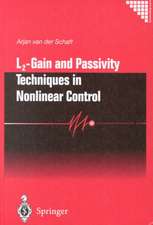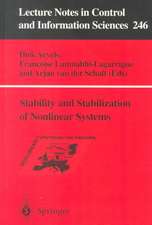L2-Gain and Passivity Techniques in Nonlinear Control: Communications and Control Engineering
Autor Arjan van der Schaften Limba Engleză Paperback – 5 iul 2018
Feedback equivalence to a passive system and resulting stabilization strategies are discussed. The passivity concepts are enriched by a generalised Hamiltonian formalism, emphasising the close relations with physical modeling and control by interconnection, and leading to novel control methodologies going beyond passivity.
The potential of L2-gain techniquesin nonlinear control, including a theory of all-pass factorizations of nonlinear systems, and of parametrization of stabilizing controllers, is demonstrated. The nonlinear H-infinity optimal control problem is also treated and the book concludes with a geometric analysis of the solution sets of Hamilton-Jacobi inequalities and their relation with Riccati inequalities for the linearization.
· L2-Gain and Passivity Techniques in Nonlinear Control (third edition) is thoroughly updated, revised, reorganized and expanded. Among the changes, readers will find:
· updated and extended coverage of dissipative systems theory
· substantial new material regarding converse passivity theorems and incremental/shifted passivity · coverage of recent developments on networks of passive systems with examples
· a completely overhauled and succinct introduction to modeling and control of port-Hamiltonian systems, followed by an exposition of port-Hamiltonian formulation of physical network dynamics
· updated treatment of all-pass factorization of nonlinear systems
The book provides graduate students and researchers in systems and control with a compact presentation of a fundamental and rapidly developing area of nonlinear control theory, illustrated by a broad range of relevant examples stemming from different application areas.
| Toate formatele și edițiile | Preț | Express |
|---|---|---|
| Paperback (1) | 1273.74 lei 6-8 săpt. | |
| Springer International Publishing – 5 iul 2018 | 1273.74 lei 6-8 săpt. | |
| Hardback (1) | 1280.18 lei 6-8 săpt. | |
| Springer International Publishing – 15 dec 2016 | 1280.18 lei 6-8 săpt. |
Din seria Communications and Control Engineering
- 15%
 Preț: 659.70 lei
Preț: 659.70 lei - 20%
 Preț: 879.74 lei
Preț: 879.74 lei - 18%
 Preț: 953.65 lei
Preț: 953.65 lei - 18%
 Preț: 1117.03 lei
Preț: 1117.03 lei - 9%
 Preț: 1385.77 lei
Preț: 1385.77 lei - 18%
 Preț: 1128.08 lei
Preț: 1128.08 lei - 18%
 Preț: 953.65 lei
Preț: 953.65 lei - 15%
 Preț: 656.89 lei
Preț: 656.89 lei - 18%
 Preț: 896.52 lei
Preț: 896.52 lei - 18%
 Preț: 1113.26 lei
Preț: 1113.26 lei - 18%
 Preț: 1388.22 lei
Preț: 1388.22 lei - 15%
 Preț: 647.27 lei
Preț: 647.27 lei - 18%
 Preț: 954.45 lei
Preț: 954.45 lei - 18%
 Preț: 1231.47 lei
Preț: 1231.47 lei - 18%
 Preț: 948.92 lei
Preț: 948.92 lei - 18%
 Preț: 1232.57 lei
Preț: 1232.57 lei - 18%
 Preț: 1127.28 lei
Preț: 1127.28 lei - 15%
 Preț: 643.34 lei
Preț: 643.34 lei - 18%
 Preț: 1401.30 lei
Preț: 1401.30 lei - 15%
 Preț: 651.51 lei
Preț: 651.51 lei - 20%
 Preț: 1454.07 lei
Preț: 1454.07 lei - 18%
 Preț: 948.79 lei
Preț: 948.79 lei - 18%
 Preț: 1233.06 lei
Preț: 1233.06 lei - 18%
 Preț: 947.85 lei
Preț: 947.85 lei - 18%
 Preț: 950.96 lei
Preț: 950.96 lei - 18%
 Preț: 956.99 lei
Preț: 956.99 lei - 15%
 Preț: 644.18 lei
Preț: 644.18 lei - 18%
 Preț: 946.87 lei
Preț: 946.87 lei - 18%
 Preț: 951.14 lei
Preț: 951.14 lei - 18%
 Preț: 961.55 lei
Preț: 961.55 lei - 15%
 Preț: 644.18 lei
Preț: 644.18 lei - 20%
 Preț: 990.80 lei
Preț: 990.80 lei - 18%
 Preț: 1006.72 lei
Preț: 1006.72 lei - 18%
 Preț: 942.44 lei
Preț: 942.44 lei - 18%
 Preț: 1233.06 lei
Preț: 1233.06 lei - 15%
 Preț: 641.85 lei
Preț: 641.85 lei - 18%
 Preț: 957.75 lei
Preț: 957.75 lei - 15%
 Preț: 649.87 lei
Preț: 649.87 lei - 18%
 Preț: 958.07 lei
Preț: 958.07 lei - 18%
 Preț: 1117.99 lei
Preț: 1117.99 lei - 18%
 Preț: 1395.94 lei
Preț: 1395.94 lei - 18%
 Preț: 781.62 lei
Preț: 781.62 lei - 18%
 Preț: 953.20 lei
Preț: 953.20 lei - 18%
 Preț: 1109.78 lei
Preț: 1109.78 lei
Preț: 1273.74 lei
Preț vechi: 1592.18 lei
-20% Nou
Puncte Express: 1911
Preț estimativ în valută:
243.76€ • 264.69$ • 204.76£
243.76€ • 264.69$ • 204.76£
Carte tipărită la comandă
Livrare economică 23 aprilie-07 mai
Preluare comenzi: 021 569.72.76
Specificații
ISBN-13: 9783319842943
ISBN-10: 3319842943
Ilustrații: XVIII, 321 p. 37 illus.
Dimensiuni: 155 x 235 mm
Greutate: 0.48 kg
Ediția:Softcover reprint of the original 3rd ed. 2017
Editura: Springer International Publishing
Colecția Springer
Seria Communications and Control Engineering
Locul publicării:Cham, Switzerland
ISBN-10: 3319842943
Ilustrații: XVIII, 321 p. 37 illus.
Dimensiuni: 155 x 235 mm
Greutate: 0.48 kg
Ediția:Softcover reprint of the original 3rd ed. 2017
Editura: Springer International Publishing
Colecția Springer
Seria Communications and Control Engineering
Locul publicării:Cham, Switzerland
Cuprins
Chapter 1: Input-Output Stability.- Chapter 2: Small-Gain and Passivity of Input–Output Maps.- Chapter 3: Dissipative Systems Theory.- Chapter 4: Passivity.- Chapter 5: Passivity by Feedback.- Chapter 6: Port-Hamiltonian Systems.- Chapter 7: Port-Hamiltonian Network Dynamics.- Chapter 8: L2-Gain and the Small Gain Theorem.- Chapter 9: Factorizations of Nonlinear Systems.- Chapter 10: Nonlinear H-infinity Control.-Chapter 11: Hamilton-Jacobi Inequalities.
Recenzii
“The book presents a well written and systematically organized text focused on a unified treatment of classical input-output stability theory and recent results in nonlinear robust and passivity-based control. … The book will be useful to advanced graduate students, researchers and applied mathematicians interested in this emerging area.” (Lubomír Bakule, zbMath 1410.93004, 2019)
“This text is sure to continue to be one of the go-to references for nonlinear control researchers and practitioners interested in both the classical and modern interpretations and applications of L2-gain and passivity methods for nonlinear systems.” (James Richard Forbes, IEEE Control Systems Magazine, December, 2017)
Notă biografică
A.J. (Arjan) van der Schaft (1955) received the undergraduate and Ph.D. degrees in Mathematics from the University of Groningen, The Netherlands, in 1979 and 1983, respectively. In 1982 he joined the Department of Applied Mathematics, University of Twente, Enschede, where he was appointed as a full professor in Mathematical Systems and Control Theory in 2000. In September 2005 he returned to Groningen as a full professor in Mathematics.
He has served as Associate Editor for Systems & Control Letters, Journal of Nonlinear Science, SIAM Journal on Control and Optimization, IEEE Transactions on Automatic Control and the European Journal of Control. Currently he is on the Editorial Board for the Journal of Geometric Mechanics and Annual Reviews in Control.
Arjan van der Schaft is Fellow of the Institute of Electrical and Electronics Engineers (IEEE) and of the International Federation of Automatic Control (IFAC). He was Invited Lecturer at the International Congress of Mathematicians, Madrid, Spain, 2006. He is the 2013 recipient of the 3-yearly awarded Certificate of Excellent Achievements} of the IFAC Technical Committee on Nonlinear Systems.
Arjan van der Schaft is (co-)author of the following other books: System Theoretic Descriptions of Physical Systems (1984), Variational and Hamiltonian Control Systems (1987, with P.E. Crouch), Nonlinear Dynamical Control Systems (1990, with H. Nijmeijer), An Introduction to Hybrid Dynamical Systems (2000, with J.M. Schumacher), Modeling and Control of Complex Physical Systems: the Port-Hamiltonian Approach( Geoplex Consortium, 2009), and Port-Hamiltonian Systems Theory: An Introductory Overview (2014, with D. Jeltsema). He (co-)edited five conference proceedings.
He (co-)authored around 125 journal articles and 265 refereed contributions to proceedings or book chapters.
He has served as Associate Editor for Systems & Control Letters, Journal of Nonlinear Science, SIAM Journal on Control and Optimization, IEEE Transactions on Automatic Control and the European Journal of Control. Currently he is on the Editorial Board for the Journal of Geometric Mechanics and Annual Reviews in Control.
Arjan van der Schaft is Fellow of the Institute of Electrical and Electronics Engineers (IEEE) and of the International Federation of Automatic Control (IFAC). He was Invited Lecturer at the International Congress of Mathematicians, Madrid, Spain, 2006. He is the 2013 recipient of the 3-yearly awarded Certificate of Excellent Achievements} of the IFAC Technical Committee on Nonlinear Systems.
Arjan van der Schaft is (co-)author of the following other books: System Theoretic Descriptions of Physical Systems (1984), Variational and Hamiltonian Control Systems (1987, with P.E. Crouch), Nonlinear Dynamical Control Systems (1990, with H. Nijmeijer), An Introduction to Hybrid Dynamical Systems (2000, with J.M. Schumacher), Modeling and Control of Complex Physical Systems: the Port-Hamiltonian Approach( Geoplex Consortium, 2009), and Port-Hamiltonian Systems Theory: An Introductory Overview (2014, with D. Jeltsema). He (co-)edited five conference proceedings.
He (co-)authored around 125 journal articles and 265 refereed contributions to proceedings or book chapters.
Textul de pe ultima copertă
This standard text gives a unified treatment of passivity and L2-gain theory for nonlinear state space systems, preceded by a compact treatment of classical passivity and small-gain theorems for nonlinear input-output maps. The synthesis between passivity and L2-gain theory is provided by the theory of dissipative systems. Specifically, the small-gain and passivity theorems and their implications for nonlinear stability and stabilization are discussed from this standpoint. The connection between L2-gain and passivity via scattering is detailed.
Feedback equivalence to a passive system and resulting stabilization strategies are discussed. The passivity concepts are enriched by a generalised Hamiltonian formalism, emphasising the close relations with physical modeling and control by interconnection, and leading to novel control methodologies going beyond passivity.
The potential of L2-gain techniquesin nonlinear control, including a theory of all-pass factorizations of nonlinear systems, and of parametrization of stabilizing controllers, is demonstrated. The nonlinear H-infinity optimal control problem is also treated and the book concludes with a geometric analysis of the solution sets of Hamilton-Jacobi inequalities and their relation with Riccati inequalities for the linearization.
· L2-Gain and Passivity Techniques in Nonlinear Control (third edition) is thoroughly updated, revised, reorganized and expanded. Among the changes, readers will find:
· updated and extended coverage of dissipative systems theory
· substantial new material regarding converse passivity theorems and incremental/shifted passivity
<· coverage of recent developments on networks of passive systems with examples· a completely overhauled and succinct introduction to modeling and control of port-Hamiltonian systems, followed by an exposition of port-Hamiltonian formulation of physical network dynamics
· updated treatment of all-pass factorization of nonlinear systems
The book provides graduate students and researchers in systems and control with a compact presentation of a fundamental and rapidly developing area of nonlinear control theory, illustrated by a broad range of relevant examples stemming from different application areas.
Feedback equivalence to a passive system and resulting stabilization strategies are discussed. The passivity concepts are enriched by a generalised Hamiltonian formalism, emphasising the close relations with physical modeling and control by interconnection, and leading to novel control methodologies going beyond passivity.
The potential of L2-gain techniquesin nonlinear control, including a theory of all-pass factorizations of nonlinear systems, and of parametrization of stabilizing controllers, is demonstrated. The nonlinear H-infinity optimal control problem is also treated and the book concludes with a geometric analysis of the solution sets of Hamilton-Jacobi inequalities and their relation with Riccati inequalities for the linearization.
· L2-Gain and Passivity Techniques in Nonlinear Control (third edition) is thoroughly updated, revised, reorganized and expanded. Among the changes, readers will find:
· updated and extended coverage of dissipative systems theory
· substantial new material regarding converse passivity theorems and incremental/shifted passivity
<· coverage of recent developments on networks of passive systems with examples· a completely overhauled and succinct introduction to modeling and control of port-Hamiltonian systems, followed by an exposition of port-Hamiltonian formulation of physical network dynamics
· updated treatment of all-pass factorization of nonlinear systems
The book provides graduate students and researchers in systems and control with a compact presentation of a fundamental and rapidly developing area of nonlinear control theory, illustrated by a broad range of relevant examples stemming from different application areas.
Caracteristici
Enriches understanding of a fundamental and rapidly developing area of nonlinear control theory Explains the small-gain and passivity theorems and their implications for stability and stabilization Expands on earlier editions with new examples of port-Hamiltonian network dynamics and coverage of converse and incremental/shifted passivity Includes supplementary material: sn.pub/extras






























